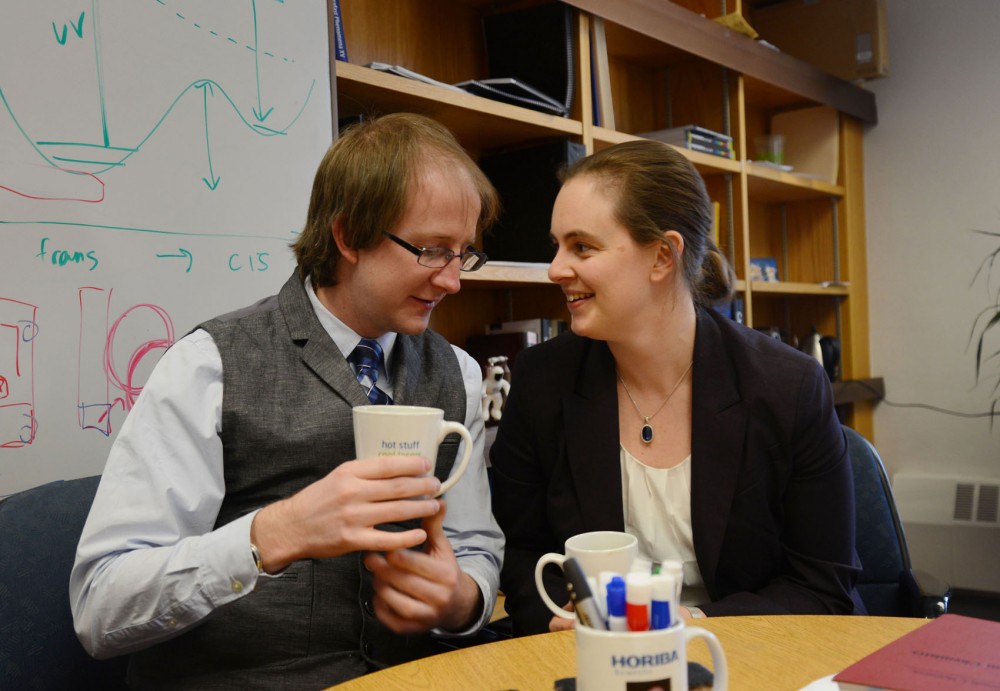James Johns swears fellow chemist Renee Frontiera noticed him first — it’s still a point of contention nine years later.
“[We] officially met in quantum mechanics class,” Frontiera said, “which is super romantic.”
After they got married, the two scientists decided living together was more important than landing the perfect job. Luckily for them, Johns and Frontiera didn’t have to choose when they both accepted positions as assistant professors in the University of Minnesota’s chemistry department last July.
Frontiera and Johns came to the University in part because they felt the institution understood and accommodated the “two-body problem” — the dilemma caused when spouses working in similar disciplines have a hard time getting jobs at the same school.
“We wanted to live and work in the same city,” Frontiera said. “A lot of people who marry scientists, spouses live separately or, you know, commute. For us, that wasn’t an option.”
Frontiera and Johns share a lab in Smith Hall, even sharing some equipment. Frontiera said sharing a lab concerned them at first because of their organizational habits and how often they’d be together.
“I would have things more organized and put in their spots, and James has, you know, piles of stuff everywhere,” Frontiera said. “We’ve always worked in different buildings, so this was by far the closest we would ever work.”
Johns said it’s nice to be able to tell each other problems they’re facing in their research, knowing the other fully understands, but he said sometimes he just wants to vent about his day without it turning into a problem-solving session.
Frontiera and Johns applied to 45 different places after they received their post-doctorates in Chicago, but out of all the places where they were accepted, they said the University of Minnesota was the most appealing.
She said she appreciated how the University found two positions while treating the couple as independent researchers — something she and Johns said is important as they try to make a name for themselves in their field. But most of all, they said the University made them feel wanted.
“We really liked the department here. There are a lot of faculty couples in the chemistry department,” Frontiera said. “I think most places are pretty used to this dilemma, but not everyone is equipped to give two positions or really willing to do that.”
Time takes its toll
Stephania Gaete and Rodrigo Bustamante met on a fish farm in their native Chile.
They were both studying to be veterinarians then, but they’ve since married and switched to conservation biology, for which they’re getting their master’s degrees at the University.
Working together so closely can have its difficulties, Gaete said.
Both are researching the kodkod, a wild cat native to Chile, and Gaete said spending so much time together can sometimes cause small fights and give them less to talk about.
“It is difficult, because you need more individuality, you need more independence,” Gaete said.
Since starting their graduate program at the University, Gaete said she and Bustamante are pressured to spend their time together. It’s different than when they’re back home in Chile, she said, because they have different friends they can see and different lives they can retreat to.
After their fellowship here, Gaete said they might work on more projects together, but in different roles. What’s important is that they stay together as a family, she said.
Balancing work life with home
Elizabeth Borer and Eric Seabloom met 20 years ago at a field lab, but at the time, Borer lived in Texas and Seabloom lived in Iowa.
Seabloom said he visited Borer, who is now his wife, in the summers. But she said those three early years were “a lot of driving, a lot of phone calls, a lot of letters.”
Since then, they have moved from job to job so they could stay together while they worked. They often found places where she could get a great job but his was “iffy,” Seabloom said.
So when the University offered them two positions, they knew it was a great fit, she said.
The associate biology professors explicitly stated their wish to work together when they applied for their faculty positions at the College of Biological Sciences in late 2009. It was important that they find a situation that balanced work and home lives, Borer said.
Borer said sharing so much of her life with someone can definitely be an uphill battle, but she said for her and Seabloom, it’s been well worth the effort. The two are now leading a project with 100 researchers collecting data around the world.
“It’s not for everyone,” Borer said. “We’ve got a really great working relationship in a lot of areas at this point. Mostly, we’re figuring out who’s picking the kids up from school and getting the groceries. Like we just have a life at home, like any couple.”


